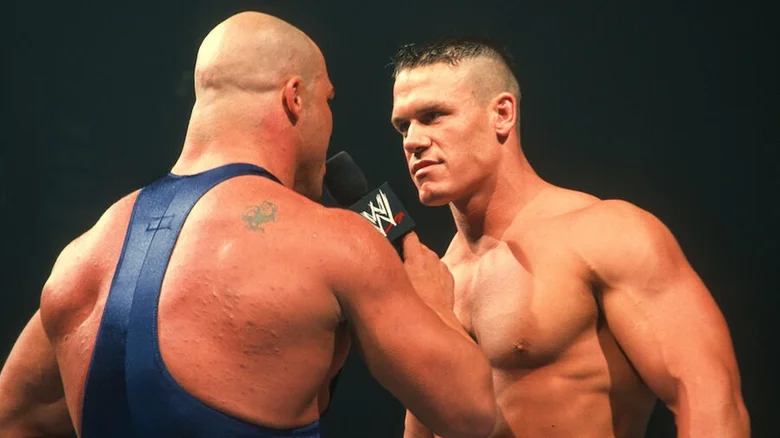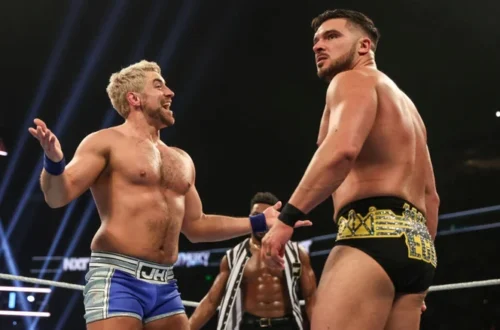Wrestling fans love stories that show how the great ones became great. This week brought a fresh one from a voice who was there from the start. WWE Hall of Famer Arn Anderson spoke about John Cena’s earliest days on the main roster and the lessons that shaped him, just as the company heads toward the final month of Cena’s farewell year. The mix of memory and reality made for a powerful segment and a timely reminder of how much work goes into building a legend.
Why Arn is talking now
The calendar explains the timing. Cena is one month away from his last match, set for Saturday Night’s Main Event on Saturday December thirteen at Capital One Arena in Washington DC. WWE made that official with a corporate announcement, and several outlets followed with detailed rundowns on the special and how it will stream on Peacock. The date is circled. The end is real. So hearing from one of Cena’s most important mentors lands with extra weight.
Cena himself set the tone earlier this summer. On Good Morning America he said there is no way he wrestles again after this year ends. He framed the promise to fans as something he intends to keep, even as he stays involved with WWE in other ways. People and ABC carried those comments, and they gave the farewell tour a sense of finality that fans have taken seriously.
The story Arn told about a raw rookie
Arn’s new comments came during an appearance on Busted Open Radio. He described getting an assignment from the boss in the early two thousands. As Anderson put it, Vince McMahon pulled him aside and said to teach the new kid how to work. Arn became the agent for Cena’s bouts and took that job for roughly a decade. That alone paints a clear picture of how close their working relationship was.

The most vivid piece involved a young Cena working with Kurt Angle. Arn said that during a match, Cena left the ring to play to a fan with a foam hand. Angle made him pay for it the moment he climbed back in. The lesson was simple and blunt. Respect the opponent in front of you. Do not turn your back on a killer like Angle. Learn in the ring, not in the crowd. Anderson recalled asking the rookie if he learned anything when he came through the curtain. The look on Cena’s face gave the answer. It was a key moment in learning how to carry himself in a live fight.
Several sites picked up the segment and reinforced the same takeaway. Anderson mentored Cena on match structure, on selling, and on how to make the other guy matter so that the comeback means something. Fightful and 411Mania both highlighted Arn’s line that he was Cena’s agent for years and that he drilled the idea of making your opponent look dangerous. It is the sort of craft note that turns a gifted athlete into a convincing lead babyface.
A quick step back to where Cena started
Hearing those details invites a look back at the tape. Fans know the famous night in June two thousand two when a fresh faced Cena marched out to answer Kurt Angle and said the words ruthless aggression before throwing the first slap. WWE’s own video library shows the sequence and the intensity that followed, even though Angle won the match. That debut became a touchstone for an era and a measuring stick for countless rookies who tried to make the same kind of splash.
There is also the developmental chapter. Before he hit SmackDown, Cena worked in Ohio Valley Wrestling as The Prototype, a muscled up creation that fit the early two thousands vibe. WWE has spotlighted that period in video features that show a young prospect trying on ideas and finding the timing that would later carry him to the top. The leap from that world to national television is where mentors like Arn Anderson matter the most.
How the radio segment unfolded
The Busted Open conversation flowed through three beats. First, Arn explained how the assignment began. Second, he painted the Kurt Angle story to show how fast the business can punish a lapse. Third, he praised the way Cena learned, adapted, and became a complete performer. Anderson stressed the importance of selling as a heroic character. He wanted Cena to make his opponents look capable early so that the audience stopped judging only by the physique and started believing the fight. The way Arn tells it, once Cena leaned into that idea, the rest came naturally. The producers who worked those years will tell you that is how main event runs are born.
Reactions from wrestlers and fans
The interview sparked a wave of responses for two reasons. Older fans enjoy these inside stories about the transition from prospect to superstar. Younger fans see the human side of a figure who has often felt larger than life. Social chatter picked up the foam hand story quickly. Clips from the Angle bout flooded timelines again, with people comparing the rookie version of Cena to the veteran who now gets standing ovations on farewell tour stops. WWE’s own platforms also leaned into the nostalgia by resurfacing classic footage from that first SmackDown.
Veterans who shared locker rooms with Cena echoed Arn’s theme. The common thread was simple. Cena always listened. He made small changes right away. He valued agents and producers. While those voices did not all appear in the radio segment, outlets that aggregated the interview placed Arn’s praise alongside past comments from agents and peers who have said the same for years. The idea that Cena respected the system is one more reason the farewell is drawing such warmth.
What the memories tell us about the final stretch
All of this lands differently because of what is coming next. WWE confirmed that the last match is locked for Saturday December thirteen at Capital One Arena. The special will stream only on Peacock as part of the new plan for Saturday Night’s Main Event. The press release makes no promise about the opponent, but creative has built the story around a tournament to pick that last dance partner. More details have rolled out across recent shows and news sites, keeping the focus on a competitive send off instead of a pure nostalgia tour.
Hearing Arn stress fundamentals fits a final year that has been all about living up to a standard. Cena has taken on hard matches, spoken carefully about not stepping back in after December, and framed the whole run as a thank you to fans. If you have followed the lessons Anderson described, it adds up. Make the other person. Sell with heart. Finish strong. Go out on the right note.
What industry voices are saying
Analysts liked that the radio segment was not just praise. It was instruction. When a respected coach calls a young star very green in his thought process, that is not an insult. It is a reality most rookies face. The key is how fast that rookie learns. Arn’s description of ten years as match agent shows sustained trust from the office and from Cena. Outlets that covered the interview pointed to this as proof that the top guy did not succeed on charisma alone. He relied on a team. He listened to that team. Then he led from the front.
Several writers also circled back to the Angle story because it carries a lesson for the current crop. Crowd work is a gift, but it must never replace ring awareness. The best can do both. They connect with fans while never taking their eyes off the fight. The moment a future Hall of Famer suplexes you for drifting is a lesson you will not forget. That single image captured why mentors matter and why some careers reach a different level.
How this shapes fan expectations for the last match
Fans want the final opponent to test everything Arn talked about. They want a rival who can push the pace, land believable offense, and bring out that classic Cena sell and rally pattern one more time. The company has teased a field with both veterans and hungry modern aces. Whoever comes through will stand across from a performer who has built entire main events on the craft points Anderson highlighted. That is part of why the finish line feels exciting instead of sad. It feels like one last study in big match construction.
A thoughtful read on Cena’s legacy through Arn’s eyes
There is a thread that runs from Ohio Valley Wrestling to SmackDown in two thousand two to the world title years and now to Washington DC in December. On one end is a prospect who did not yet know when to turn to the crowd. In the middle is a worker who learned to build opponents so that his comeback meant something. On the other end is a veteran who wants to end the story with clarity and respect for the audience. Arn’s stories help stitch those points together. They show that the journey was not magic. It was coaching, repetition, and humility in the face of failure.
What happens after the final bell
Cena has been clear that he will stay connected to WWE even after he hangs up the boots. Interviews this year framed that future as mentorship and advocacy, not more matches. If that holds, then the advice pipeline that helped him will run the other direction. You can imagine a future segment where a young star describes the lesson John passed along during a tough loop on the road. The circle closes. A generation that watched him carry the show will get direct guidance from the man himself.
Final word and a look ahead
Arn Anderson did not simply share a cute memory. He walked fans into the classroom where John Cena learned. He showed the mistake, the pain, and the fix. He reminded us that the brightest careers rely on voices off camera as much as they rely on the roar of the crowd. Hearing that now, with the last match set for December, makes the farewell feel richer. We are not just saying goodbye to ring gear and theme music. We are celebrating a craft that was taught, learned, and then shared with millions.
As the field for the last opponent settles, expect WWE to lean even more into this theme. Training. Respect. Selling. Big match timing. Whoever gets the nod will step into a main event that celebrates those ideas. If the final image is a proud mentor watching from the crowd while his former pupil takes one last bow, no one will complain. It would fit the story perfectly. It would honor the work that started when a very green kid walked through the curtain and met a teacher who knew exactly what he needed.





